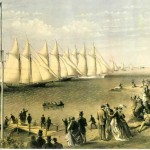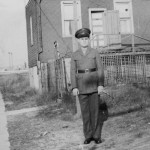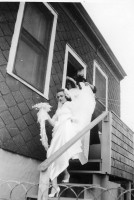by Maureen Wlodarczyk

The draw of our state’s coastal waters as a venue for family outings, water sports or the opportunity to step aboard and spend a day fishing or lounging on deck has been a long-standing constant of life in New Jersey, north and south. Hudson County, for instance, was home to many yacht clubs in the 19th century, some of those organized just before and after the Civil War.
The Hudson Yacht Club was organized in 1877, its original incorporators almost entirely made up of county and city officials including Sheriff P. H. Laverty and Judge Hoffman. That same year the Club purchased, at a cost of $4,000, a steam yacht measuring 51 feet long and 10.5 feet wide, naming the vessel Annie L. after the Sheriff’s wife. A steam yacht was chosen to avoid the nuisance of dealing with poor wind conditions and the Annie L. served the club members well, carrying them on excursions to seaside resorts, her larder stocked with food and a good selection of wines to insure a pleasant journey. Roughing it this was not.Â

 The Oceanic Yacht Club was formed in 1871 and had its club house at the foot of Henderson Street in Jersey City. In 1878, its fleet included 13 sailing yachts, one catamaran, and one steam launch and the club numbered about 40 members. Still active 20 years later, in 1899 the club had over 60 members, a fleet of 18 vessels, and had purchased a site at the foot of Communipaw Avenue on which an attractive new club house was to be built. Â

Regattas were sponsored by the various yacht clubs as pleasure outings or competitions. In 1870, the Bayonne Yacht Club held its 4th annual regatta, hosting 15 yachts from its own membership along with others affiliated with the Oceanic, Brooklyn, Americus, Atlantic, Union and Harlem Yacht Clubs. Two decades later in May 1896, multiple regattas marked the opening of the boating season. The Pavonia Yacht Club regatta set off from Jersey City racing to Sandy Hook for a celebration there. The Oceanic Yacht Club held its regatta on a 10-mile course mapped out on the waters of Newark Bay. The Jersey City Yacht Club observed their long-time tradition of a short sail followed by a chowder dinner.

There is one more yacht club I should mention, as I believe it may have a personal connection to my family: the Newark Bay Yacht Club. In 1909, that club held a reception celebrating the opening of its new club house located on Pearsall Avenue at Newark Bay in the Greenville section of Jersey City. Nearly a half-century later when I was born at the Margaret Hague, my parents brought me home to a very modest, flat-top, red-shingled home located at the foot of Pearsall Avenue next to the railroad tracks and Newark Bay, a building that had started life as a club house.

The “Red House†as we all called it, was leased to my grandparents by the railroad for one dollar a year. My mother and her five brothers spent most of their happy childhood in the Red House during and after the Depression and my mother’s wedding photos capture her coming down its no-frills porch steps. In the 1950s, my father, barbecuing too close to those red shingles, set the place on fire. When my mother tells the fire story, she always mentions that I had been napping inside just before the shingles went up and, but for her having picked me up from my crib and taken me out into the yard with her, I might have been toast. Jersey City’s brave firemen saved the Red House from destruction although the water and smoke damage made for quite a clean-up.
I cannot say for certain that three generations of my Jersey City family lived many happy days at what was once the Newark Bay Yacht Club but, if you checked the 1940 census records, you would see that my grandparents lived in the last house at the foot of Pearsall Avenue, next to Newark Bay.Â
Maureen Wlodarczyk is a fourth-generation-born Jersey City girl and the author of three books about life in Jersey City in the 1800s and early 1900s:Â Past-Forward: A Three-Decade and Three-Thousand-Mile Journey Home, Young & Wicked: The Death of a Wayward Girl and Canary in a Cage: The Smith-Bennett Murder Case. Â For info: www.past-forward.com.
Â
Â
